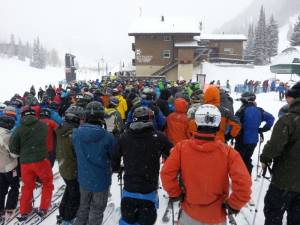Denver, CO – As of Nov. 30, on-the-books occupancy at 16 mountain ski resort destinations across California, Colorado, Utah and Oregon for December 2012 is down a sharp 12.3 percent compared to the same time last year although the Average Daily Rate (ADR) posted a slight gain, up 2.6 percent, according to the most recent data released by the Mountain Travel Research Program (MTRiP).
Looking at the long-range view, the monthly MTRiP briefing reported that on-the-books occupancy for arrivals in December through May 2013 is down only 2.8 percent compared to the same time last year. Very slight gains were posted in January and February while December, March, April, and May are currently showing declines.
“Although reports about the looming ‘fiscal cliff’ have dominated the national news ever since the election, the discussion in mountain communities is very snow-centric as snowfall was below average in most locations for most of November and into early December,” observes Ralf Garrison, director of MTRiP. “As a result, overall advance reservation activity continues to lag, and overall seasonal occupancy is still trending down with December’s holiday season well behind historic levels.

The monthly briefing noted that despite lack of natural snowfall in the early season, actual occupancy among participating mountain destinations was up 7.5 percent year-over-year in November compared to last year. The ADR also climbed for the 18th consecutive month—up 4.2 percent for November. The results are aggregated from all participating resorts and the staff at MTRiP cautions that there was considerable variation among destinations in this month’s results.
“Since this data was collected and compiled, many mountain destinations have received much needed snow and a commensurate bump in reservation activity but it is likely too little, too late to help December occupancy and will almost certainly result in declines from last December,” admitted Garrison. “The mid-season strength is gratifying, but even those figures are vulnerable to early season momentum and messaging from holiday visitors,” he further cautioned.
In the wake of dismal storm patterns, the Briefing also focused on climate change and the ski industry. It emphasized that the ski and snowboard industry is deeply vested in keeping winters cold and snowy—regardless of political disagreements about the causes.
Other factors shaping the activity of winter visitors are several key economic indicators. On the positive side, the Consumer Confidence Index crept up 0.8 percent in November to 73.7 and marks only the fourth time in 24 months that the Index has been above 70. The Unemployment Rate dropped two basis points from 7.9 to 7.7 percent to its lowest level since December 2008 with the addition 146,000 new jobs in the private sector–nearly double the amount of jobs projected. The 3.2 percent decline in crude oil prices was also viewed as timely since it brings relief at both the pump and in the cost of most goods going into the prime holiday shopping and travel season. However, the second consecutive monthly decline in the Dow Jones Industrial Average was cause for concern although it closed the month about the 13,000-point mark for the fifth consecutive month.
“As investors turned their attention from the federal election to the fiscal cliff debate, the Dow dropped a dramatic 690 points in the first two weeks of November but a combination of strong holiday spending and a sense of improving consumer confidence helped it recover by mid-month,” explained Tom Foley, operations director for MTRiP. “Some progress in the Euro zone added to the recovery but markets will remain volatile for the next two weeks as lawmakers in Washington, D.C. wrestle towards their Dec. 31 economic deadline.

